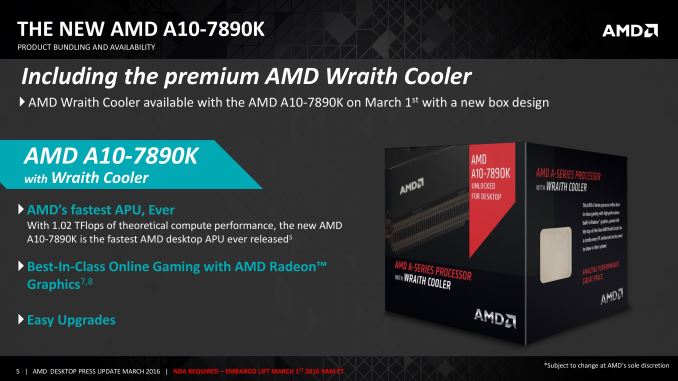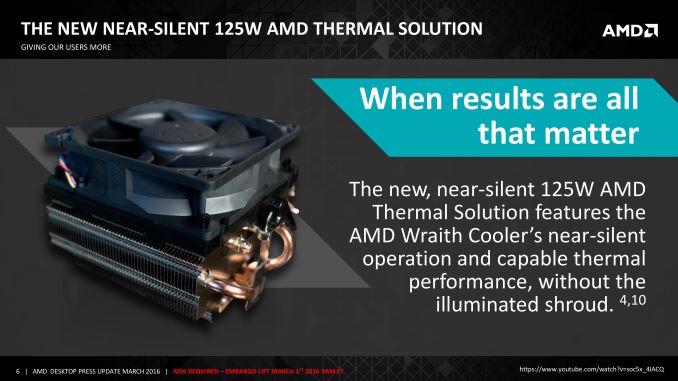AMD Launches the A10-7890K and Athlon X4 880K
by Ian Cutress on March 1, 2016 9:00 AM EST- Posted in
- CPUs
- AMD
- Cases/Cooling/PSUs
- APUs
- Athlon

In what seems to be a common theme every month, AMD’s recent APU release schedule has been to introduce one or two models each news cycle. For the most part, the new elements so far this year have been increases in frequency and efficiency, either replacing previous units or expanding the product stack. This is usually due to adjustments in binning the silicon as it gets produced, or minor improvements in the back-end of production that gives efficiency benefits.
So far this year we have seen the A10-7860K and the A6-7470K, both adjustments to the stack, but using some of AMD’s new 65W/95W CPU coolers. We also saw the announcement of the Athlon X4 845 which was interesting as it stands to be the single processor from AMD that is based on Excavator for the FM2+ platform. Today AMD is announcing two new processors which sit on the top of their FM2+ stacks respectively – the A10-7890K is an APU with increased frequencies, while the Athlon X4 880K is similar without the integrated graphics.
| AMD A10 and Athlon X4 Kaveri Lineup | ||||||
| A10- 7890K |
A10- 7870K |
A10- 7860K |
X4 880K |
X4 860K |
X4 845 |
|
| Modules | 2 | 2 | 2 | 2 | 2 | 2 |
| Threads | 4 | 4 | 4 | 4 | 4 | 4 |
| Core Freq. (GHz) | 4.1-4.3 | 3.9-4.1 | 3.6-4.0 | 4.0-4.2 | 3.7-4.0 | 3.5-3.8 |
| Compute Units | 4+8 | 4+8 | 4+8 | 4+0 | 4+0 | 4+0 |
| Streaming Processors |
512 | 512 | 512 | N/A | N/A | N/A |
| IGP Freq. (MHz) | 866 | 866 | 754 | N/A | N/A | N/A |
| TDP | 95W | 95W | 65W | 95W | 95W | 65W |
| Cooler | Wraith | 125W NS |
125W NS |
125W NS |
95W NS |
95W NS |
| DRAM Frequency |
2133 | 2133 | 2133 | 2133 | 1866 | 2133 |
| L2 Cache | 2x2MB | 2x2MB | 2x2MB | 2x2MB | 2x2MB | 2x1MB |
The A10-7890K will use a 4.1 GHz base frequency, moving up to 4.3 GHz on turbo, with 8 graphics compute units (512 streaming processors total) at 866 MHz. This is all within the 95W thermal envelope, and the A10-7890K will be the second processor from AMD bundled with their new Wraith cooler, rated at 125W with a shroud and LEDs. The Athlon X4 880K will have similar specifications at 100 MHz less, but without the integrated graphics. It is also rated at 95W, but instead gets AMD’s new 125W ‘near-silent’ thermal solution, which is essentially the Wraith cooler without the shroud (which apparently adds a couple dB due to vibration).
Both the X4 880K and the now second highest APU, the A10-7870K, will get this new 125W ‘near-silent’ thermal solution. The other A10 and X4-800 series members will get the new 95W thermal solution, which is a modified version of the high end cooler we normally associate with AMD. AMD has stated that parts that get the new coolers will not be sold for more than their current suggested retail pricing, except the FX-8370 previously announced.
These parts are being made available to the channel and distributors today, although it may take up to a month to hit the shelves for end-users to purchase (there’s no specific date set). Pricing for all the new parts are listed as follows:
- AMD FX™ 8370 Wraith - $199.99 USD
- AMD FX™ 8370 - $189.99 USD
- AMD A10-7890K – $164.99 USD
- AMD A10-7870K – $139.99 USD
- AMD A10-7860K - $117.99 USD
- AMD A8-7670K - $105.99 USD
- AMD A8-7650K - $95.99 USD
- AMD Athlon™ X4 880K – $94.99 USD
- AMD Athlon™ X4 870K - $89.99 USD
- AMD Athlon™ X4 860K - $79.99 USD
- AMD Athlon™ X4 845 - $69.99 USD
We have samples inbound, and I have plans to revisit our APU data to update the parts with our most up-to-date benchmark suite. Keep an eye out for that in the next couple of months.
Source: AMD



















63 Comments
View All Comments
drgoodie - Tuesday, March 15, 2016 - link
It's true that Intel's iGPUs are catching up, but there is still a significant difference in compute and higher resolution performance. The only area where Intel has caught up is with systems that have eDRAM. AMD's integrated graphics still have an edge.hojnikb - Tuesday, March 1, 2016 - link
I really wished 880K was an excavator part ;(Alexvrb - Wednesday, March 2, 2016 - link
Excavator in current Carrizo form isn't designed to clock really high. Hence why they released Excavator on desktop as the 835/845. If they had an unlocked one though I'd still like to tinker with it just for the heck of it. IPC gains are definitely there.Maybe on AM4.
bittermann - Tuesday, March 1, 2016 - link
At those prices they should include a motherboard. Just sayin...bug77 - Tuesday, March 1, 2016 - link
How on Earth does the X4 880K comes clocked 100MHz lower than A10-7890K, lacks the iGPU, yet still rated at the same TDP? The 100MHz is nothing, but you'd think the iGPU must account for something.danwat1234 - Tuesday, March 1, 2016 - link
I 2nd your question;Since the new APU and CPU have just about the same CPU core clockspeeds, and the same TDP, I suppose the APU will throttle down the CPU core clocks if the GPU is heavily utilized. Or it's let it go beyond the TDP if temps are fine?
NeatOman - Tuesday, March 1, 2016 - link
The cooler is much better on the A10-7890K which is the only real improvement AMD has made.jordanclock - Tuesday, March 1, 2016 - link
The TDP for AMD and Intel refer more to the power budget, not the power usage. That means the Athlon can likely hit peak speeds longer before hitting thermal limits.eldakka - Tuesday, March 1, 2016 - link
Not to mention that they have specific TDP categories. These are ranges, not exact numbers. Because a part is listed as 95W or 65W doesn't necessarily mean it will hit 95W or 65W, it just means its less than or equal to it's category and greater then the next lower category. So a 95W part can be anywhere from 66W to 95W. a 65W part is anywhere from 46W to 65W.Therefore the 7890K might be a 95W part that hits 95W, but the 880K might be a 95W CATEGORY part, but it maxes out at 75W. So they can't call it a 65W part because it's above 65W, but they don't want to complicate the market by having more categories like 75W, 85W and so on.
artk2219 - Wednesday, March 9, 2016 - link
Binning. Sure the iGPU isnt working but its still using power just being there, and typically since its considered partially defective silicon, they feel that they would probably need to run more voltage through it just to keep it stable. The higher voltage part isnt necessarily true for every chip since im sure there are loads that have no issues running at much lower voltage (and that would probably still have a decent GPU if it weren't physically disabled). But they hedge their bets, and they also have TDP tiers. Anything over 65 Watts is automatically a 95 Watt part, even though it may only use like 68 Watts.